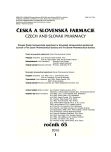Thin-layer chromatography application for the standardization of Sophora flowers
Authors:
Anna Kriukova; Inna Vladymyrova
Authors place of work:
The National University of Pharmacy, Kharkiv, Ukraine
Published in the journal:
Čes. slov. Farm., 2016; 65, 34-35
Category:
44<sup>th</sup> Conference drug synthesis and analysis
Introduction
Herbal products contain multiple constituents that might be responsible for its therapeutic effects. Thus it is necessary to define as many constituents as possible in order to understand and explain their bioactivity. According to this concept, a chemical profile for herbal product is constructed and compared with the profile of a clinically proven reference product. Since many of these preparations contain flavonoids, it is essential to have adequate analytical techniques at hand for this class of natural products. Various analytical methods exist for flavonoids definition.
Paper chromatography is widely used for the analysis of flavonoids, but now there are more modern methods of analysis, and simple and inexpensive thin-layer chromatography (TLC) is one of them.
There are many kinds of the systems solvent/eluent used for the separation of flavonoids using TLC. With regard to detection, flavonoids spot on TLC plates produce a yellow-brown spots white background when reacted with iodine vapour. Flavonoids may appear as dark spots on a green background fluoresce when observed in UV light at 254 nm UV-plates containing a fluorescent indicator (such as silica gel F254). If under 365 nm UV light, spot colours depending on the structure of flavonoids can be yellow, green or blue fluorescent. It would be more clear and intense after being sprayed with the reagent.
The aim of our work was to develop an identification method of flavonoids in Sophora japonica flowers, presented in Ukraine for the creation of national regulatory documents. For the basis we took the method of flavonoids determination displayed in the European Pharmacopoeia (EPh) 8.3 Monograph “Sophora Flower”.
Experimental methods
For the preparation of the test solutions to 1 g of the powdered herbal drug (355) (2.9.12) we added 5.0 mL of methanol R, sonicated for 10 min and then filtered.
For the preparation of the reference solutions, standard samples of 10 mg hyperoside R and 10 mg rutin R which was dissolved in 10 mL methanol R were used.
The solutions were applied as bands of 10 μL on the starting line of the chromatographic silica gel plate R (5–40 μm). Then the plate was immersed in the solvent system: anhydrous formic acid R, water R, ethyl acetate R (10 : 10 : 80). Development over the path of 10 cm. After that, the plate was dried in air.
Detection was performed using a 10 g/L solution of diphenylboric acid aminoethyl ester R in methanol R and then with a 50 g/L solution of macrogol 400 R in methanol R. Next, the plate was dried in air for 30 minutes and examined in ultraviolet light at 365 nm. The results were evaluated by viewing the plate under UV light at 365 nm.
Results and discussion
For the analysis of the obtained results, the size, colour, fluorescence zones, location and clarity of their separation on the chromatogram of the reference solution and the test solution were compared (Fig. 1).

In the resulting chromatogram, a zone of orange-yellow at the zone level of the standard sample rutin that matched its size and intensity of colour was observed. Above the rutin zone there were two areas of green colour that may fit kaempferol, isorhamnetin. Approximately at the zone level of hyperoside there was a brown zone. Closer to the finish line we observed an area of orange-yellow colour which may be due to the presence of quercetin in Sophora japonica flowers.
Performed chromatographic analysis was characterized by a high quality of the obtained chromatograms, a clear distribution of substances and reproducibility.
Conclusions
Thus, in the flowers of Sophora japonica flavonoid substances of nature with reliable determinations of the contents of rutin and hyperoside were identified. Determination was performed using standard samples.
This TLC method, which is presented in the EPh 8.3 Monograph “Sophora Flower”, can be proposed for the introduction in the domestic regulatory documentation in the form of monographs of the State Pharmacopoeia of Ukraine “Sophora Flower”. Conditions of the chromatographic analysis are optimal for their application in the analysis of Sophora japonica, represented in Ukraine.
In favour of this technique it should also be noted that, in the development of monographs of the State Pharmacopoeia of Ukraine on medicinal herbs, it primarily deals with the qualitative and quantitative analysis techniques presented in the EPh, due to the harmonization of the State Pharmacopoeia of Ukraine with the EPh and the desire to fit modern quality requirements pertaining to medicinal plants.
Conflict of interest: none.
Anna Kriukova
The National University of Pharmacy
Vosstaniya square 17,
61001 Kharkov,
Ukraine
e-mail: anna.krukova@rambler.ru
Zdroje
1. European Pharmacopoeia. 8th ed. Strasbourg: European Department for the Quality of Medicines 2015.
2. Kotov A. G. Rules of presentation and procedure of development of monographs for herbal drugs. Management, economics and quality
assurance in pharmacy 2012; 1(21).
3. Bandyukova V. A., Shinkarenko A. L. The thin-layer chromato - graphy of flavonoids. Chemistry of Natural Compounds 1973; 17–21.
4. Varinskii B. A., Khil’ko, N. A., Petrenko V. V. Express method for the quantitative determination of the total flavonoids in the flowers
of Sophora japonica. Chemistry of Natural Compounds 1999; 215–216.
Štítky
Farmácia FarmakológiaČlánok vyšiel v časopise
Česká a slovenská farmacie

2016 Číslo 1
Najčítanejšie v tomto čísle
- Farmakognózia. Biologicky aktívne rastlinné metabolity a ich zdroje.
- Oral films as perspective dosage form
- Antimicrobial, antiparasitic and anticancer properties of Hibiscus sabdariffa (L.) and its phytochemicals: in vitro and in vivo studies
- The relationship of lipid imbalance and chronic inflammation mediated by PPAR
